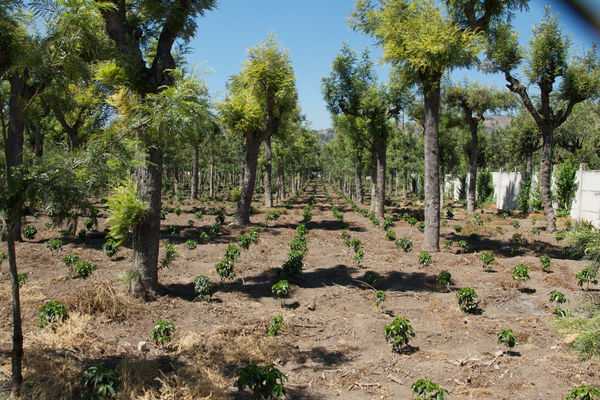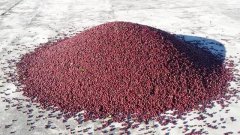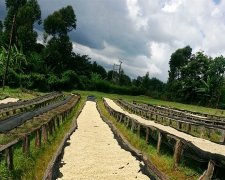Guatemala Antigua Coffee Baking Guatemala Antigua Coffee Belacamona-Flower God

Baking degree: medium baking
Treatment: washing
Flavor: elegant floral aroma as the main axis, followed by the sweetness of melons and fruits, chocolate nut finish, vanilla cream aroma, mellow.
Friends who are new to coffee often ask which coffee to start the journey, and we usually recommend this Antigua flower god with sweet fruit, smooth taste and low acidity. When brewing, you can feel the soft fragrance of flowers and the aftertaste of nut chocolate, and the sweetness of Huigan has the feeling of drinking good tea. When you don't know where to start among so many coffee items, just choose Flower God:)
Antigua Coffee (Source: https://www.ergoscoffee.com/collections/new-arrival/products/331-shb-magarita-antigua-washed)
The Antigua Valley of Guatemala has long been the most famous coffee producing area in Guatemala, and the microclimate of the Antigua Valley is known all over the world for providing excellent conditions for growing coffee. The road to fame in this producing area began with excellent coffee, which was discovered by some Japanese coffee traders decades ago. The combination of rich volcanic soil, low humidity, sufficient sunlight and strong temperature difference between day and night have created the personality of coffee in Antigua. The valley consists of three volcanoes: Agua, Acatenango and Fuego. Every once in a while, the Fuego volcano adds fresh and rich ash to the environment. These volcanic ash are rich in minerals and also provide soil growth conditions to help retain moisture to resist the dry climate of Antigua. Like all coffee grown in Guatemala, Antigua coffee grows in the shade of trees, which not only protect coffee from cold nights from December to January, but also create an ecological corridor for wildlife in this subtropical region.
Micro climate information
Climate: the climate in this area is mild, with an average annual temperature of 22 °C. The Antigua Valley is surrounded by mountains and volcanoes to protect it from the north wind.
Height: located at 1500 meters above sea level, producing very hard beans (SHB) quality coffee.
Weather: the rainy season lasts six months from May to October and the dry season from November to April. In the dry season, the temperature is about 14 °C from November to January, while the average temperature from February to April is 24 °C. Such a unique climate creates a special coffee producing area. The average annual rainfall is about 1200 Muhami 1500 mm.
Soil: volcanic soil mixed with fresh volcanic ash is rich in minerals and nutrients and is an ideal element for coffee growth. This area and valley used to be a lake, so the sediment left behind makes the land fertile and strongly characteristic, affecting the unique quality of coffee.
Planting: most coffee is grown in Arabica bourbon and is grown in the shade of Gravilea trees. Coffee is carefully picked and selected artificially when it is ripe, and then transported to the La Esperanza water washing plant on the outskirts of Antigua.
Coffee treatment: the coffee is carefully treated in the washing field and the coffee beans are separated by a peeling machine. The final pulp is then removed by fermentation and washed with clean water. The coffee is 75% sun-dried. Carefully dry according to customer requirements and ensure that each bag has a consistent quality, as is the case with every harvest.
Season: the flowering season begins in late April or early May, and the harvest period is from December to March. Such high-quality raw coffee beans are usually available in mid-January.
Important Notice :
前街咖啡 FrontStreet Coffee has moved to new addredd:
FrontStreet Coffee Address: 315,Donghua East Road,GuangZhou
Tel:020 38364473
- Prev

Guatemala High altitude Fine Coffee Manor-La Bella Biya Manor Guatemala Excellence Cup New
For the exchange of professional baristas, please follow the coffee workshop (official Wechat account cafe_style) in the early days, the Las Minas Mountains were cold because of their high altitude and latitude, which made it impossible for the area to grow coffee. However, with the influence of Greenhouse Effect, high-altitude boutique coffee cultivation is gradually found in the Las Minas Mountains, of which the most famous is this Biya Manor (
- Next

An introduction to the producing area of Xidamo, Ethiopia, which describes the flavor of hand-made parameters in Xidamo.
For the exchange of professional baristas, please pay attention to the specific techniques of the coffee workshop (Wechat official account cafe_style): [three times cut off water] hand flushing method, 15g powder, small Fuji ghost tooth knife 3.5.Grinding, v60 filter cup, 91-92 degrees water temperature, 30g water injection for the first time, 35 s steaming, water cut off to 104g water, wait for powder bed water to go down to half and then water injection, slow water injection until 220g water, tail
Related
- Detailed explanation of Jadeite planting Land in Panamanian Jadeite Manor introduction to the grading system of Jadeite competitive bidding, Red bid, Green bid and Rose Summer
- Story of Coffee planting in Brenka region of Costa Rica Stonehenge Manor anaerobic heavy honey treatment of flavor mouth
- What's on the barrel of Blue Mountain Coffee beans?
- Can American coffee also pull flowers? How to use hot American style to pull out a good-looking pattern?
- Can you make a cold extract with coffee beans? What is the right proportion for cold-extracted coffee formula?
- Indonesian PWN Gold Mandrine Coffee Origin Features Flavor How to Chong? Mandolin coffee is American.
- A brief introduction to the flavor characteristics of Brazilian yellow bourbon coffee beans
- What is the effect of different water quality on the flavor of cold-extracted coffee? What kind of water is best for brewing coffee?
- Why do you think of Rose Summer whenever you mention Panamanian coffee?
- Introduction to the characteristics of authentic blue mountain coffee bean producing areas? What is the CIB Coffee Authority in Jamaica?

